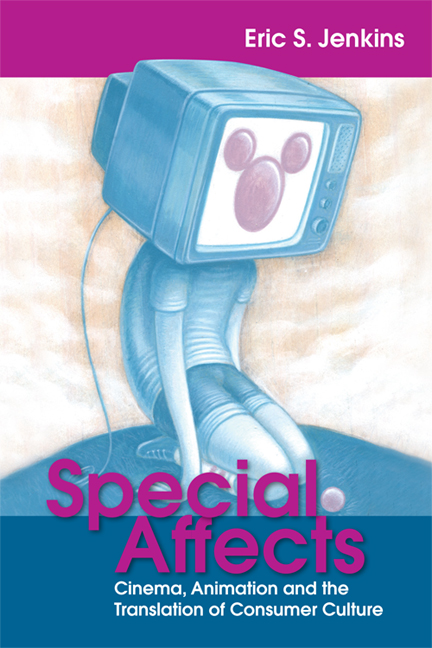Book contents
- Frontmatter
- Contents
- Acknowledgements
- List of Illustrations
- 1 Introduction
- 2 Astonishment and the Fantastic in Live-Action Cinema
- 3 Say Cheese! The Cinematic Lifestyle Consumer
- 4 Animation's Marvel and the Graphic Narrative Mode
- 5 Of Mice and Mimesis: The Wondrous Spark of Disney
- 6 Mutual Affection-Images and Daydreaming Consumers
- 7 The Disney Version of the American Dream
- 8 Walt and Wall-E in Control Society
- Movies Referenced in Special Affects
- Notes
- Index
4 - Animation's Marvel and the Graphic Narrative Mode
Published online by Cambridge University Press: 05 August 2016
- Frontmatter
- Contents
- Acknowledgements
- List of Illustrations
- 1 Introduction
- 2 Astonishment and the Fantastic in Live-Action Cinema
- 3 Say Cheese! The Cinematic Lifestyle Consumer
- 4 Animation's Marvel and the Graphic Narrative Mode
- 5 Of Mice and Mimesis: The Wondrous Spark of Disney
- 6 Mutual Affection-Images and Daydreaming Consumers
- 7 The Disney Version of the American Dream
- 8 Walt and Wall-E in Control Society
- Movies Referenced in Special Affects
- Notes
- Index
Summary
Disney translates both classical cinema and earlier animation into mutualaffection images, an interface for the mode of animistic mimesis, forming a hybrid movement-time-image. Translating both live action and animation should come as no surprise, since the two media have always had an intertwined historical relationship. Cinema began as animation, a descendant of devices like the magic lantern, praxinoscope and Emile Reynaud's Optical Theatre. These devices work similarly to flip books, passing images quickly before the eye to give the perception of movement (what is called apparent movement due to the ‘phi effect’). How to create apparent movement was known by the time Athanasius Kircher described the process in 1646, and by the 1850s numerous devices existed to create apparent movement. Such devices helped constitute what Nicolas Dulac and André Gaudreault call the ‘cultural series of animated pictures’. Cinema started as one of these series; in fact, some accounts originally gave the name ‘animated photographs’ to the images shown by Edison's Vitascope and the Lumière's Cinématographe. Thus tracing Disney's translation into animisitic mimesis requires outlining not just classical cinema but earlier animation as well.
Indeed, Disney's hybridity results from how they translate the -abilities and modes of earlier animation. Animation comes with different -abilities from live-action cinema that we will call transformability and transferability. Early animation, especially during the 1920s, will relate animation's transformability to the viewer's capacity to perceive form and trajectory, resulting in a mode of graphic narrative that, from the viewer's perspective, entails perceiving moving lines as animated characters. The graphic narrative mode, like much other early animation that emphasises transformability, illustrates the affective differences with live-action cinema outlined in the previous chapter. Since drawn animation does not offer the lifelike quality of the photograph, its spark is distinct and greeted that way in the historical record. Audiences were not so much astonished at lifelike movement but marvelled over the artificial movement and repeatedly distinguished their affections from live action.
Indeed, before the movie camera, the animated screen was associated with magic and mystery, not realism, indicating the different affections of animation. After, promoters stress the realism and lifelike quality of photographic movement, explicitly distinguishing them from the tricks of animation.
- Type
- Chapter
- Information
- Special AffectsCinema, Animation and the Translation of Consumer Culture, pp. 87 - 109Publisher: Edinburgh University PressPrint publication year: 2014



